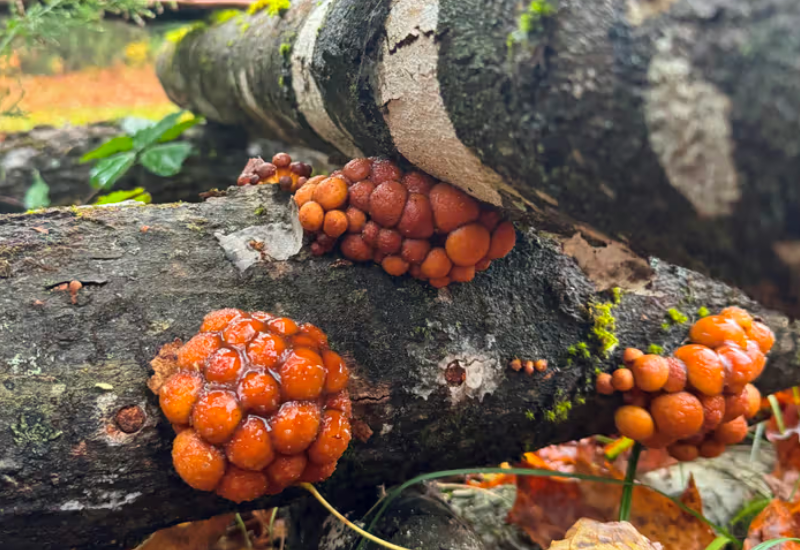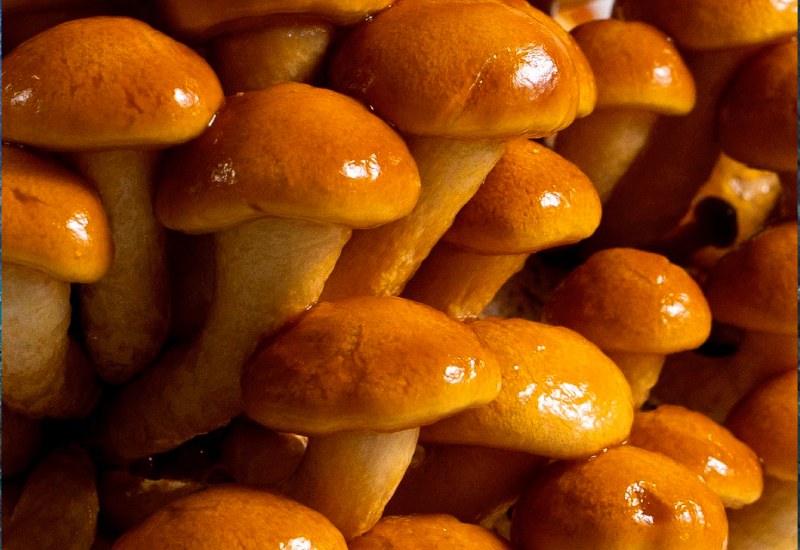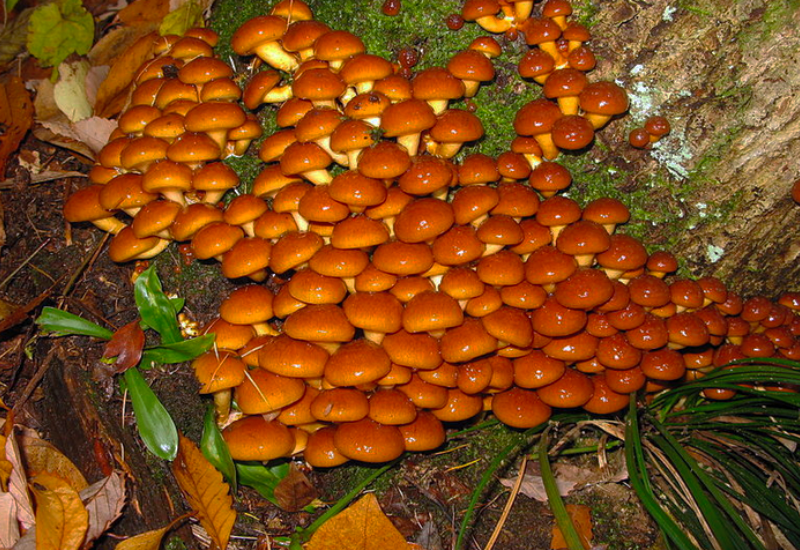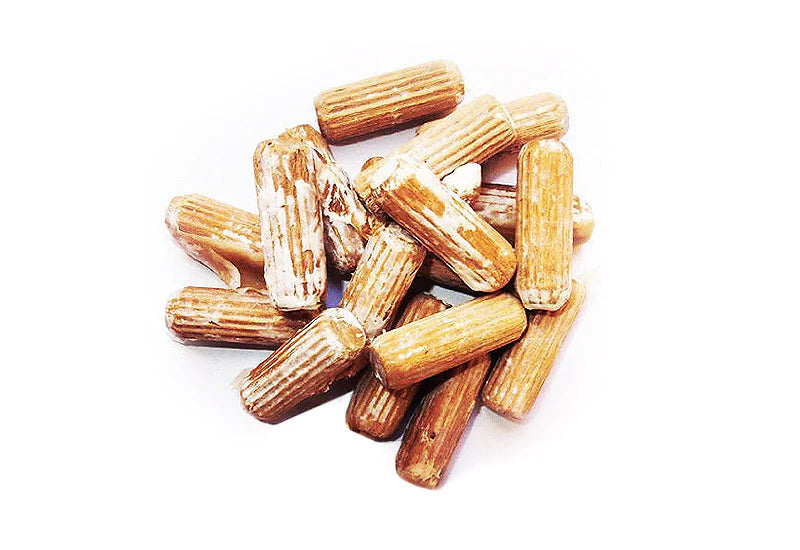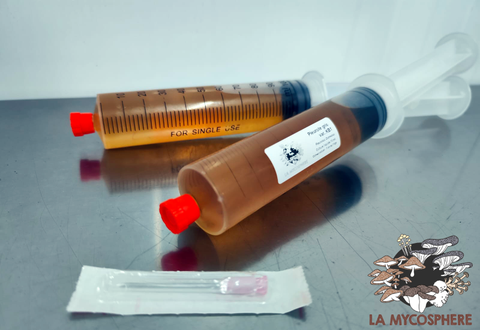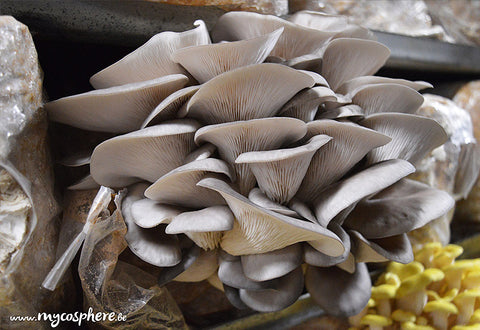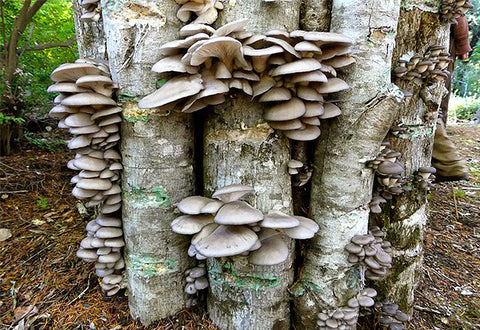Nameko - Organic mycelium on wooden dowels
- 🍄 MYCELIUM ON DOWELS – NAMEKO: Pholiota microspora (syn. P. nameko), ideal for cultivation on hardwood: beech, birch, oak, poplar, alder.
- 🌱 EASY CULTIVATION: Drill, insert the dowels, then seal the holes (wax recommended). A drill and an appropriate wood bit are sufficient.
- 🌳 ADAPTABILITY TO SPECIES: Nameko particularly likes beech and birch, but also fruits very well on oak, poplar, and alder.
- 🍽️ FLAVOR & NUTRIENTS: Mild umami flavor, hazelnut notes; naturally gelatinous cap that provides a delicate binder to soups and sauces. Source of fiber and beta-glucans.
- 🌍 ORGANIC PRODUCTION: Certified "BE-BIO-01", grown without pesticides or GMOs, environmentally friendly.
- 📏 PRACTICAL DETAILS: ~50 dowels per log of 100 cm × 20 cm. Storage: ~3 months in the refrigerator (2–6 °C) before use.
-
2-3 weeks. If in stock, we will send them to you within a week. Consult all our deadlines
Pholiota microspora
Star in Japan, still little known here: the Nameko grows in amber clusters whose cap, naturally gelled, coats soups and sauces with a round umami. When cooked, it develops woody notes with hints of hazelnut / caramel and a very tasty crunchy texture. Cultivate it on hardwood logs outdoors and harvest in cool weather (autumn / spring).
Why you will love it
- Taste & texture: gelatinous veil that naturally binds broths and sauces, pleasant crunch.
- Culinary signature: perfect for soups, woks, risottos, noodles, eggs.
- Outdoor cultivation: tight clusters on logs, peaks in cool and humid season.
- Rarity: almost impossible to find fresh — make the difference with your own harvests.
Cultivation specifications
- Level: rather intermediate/advanced (more technical than shiitake/oyster mushroom).
- Location: outdoors, on logs or stumps. Mainly fruits in autumn.
- Incubation: aim for 12–18 months for first harvests depending on essence/diameter and climate.
- Fruiting: optimal around 7–18 °C with constant humidity; avoid hot and dry places and climates. Nameko likes coolness and constant humidity.
- Recommended essences: ideal — beech, oak, maple, hornbeam, wild cherry, chestnut, poplar/cottonwood, birch; other possible — alder, ash, elm, eucalyptus, mulberry. To avoid: coniferous resinous.
Recipe idea (ready in 15 min) – Nameko & tofu miso Donburi
-
Ingredients (2 persons): 300 g nameko, 200 g firm tofu, 1 tbsp miso, 1 tbsp soy sauce, 1 tbsp mirin (or white wine), 1 clove garlic, 1 small piece ginger, 2 bowls hot rice, spring onion/sesame.
-
Step by step :
-
Briefly rinse the nameko (do not soak).
-
Pan-fry diced tofu until golden. Set aside.
-
Sauté the nameko for 3–4 min (their gelled juice comes out), add garlic/ginger.
-
Deglaze with soy + mirin, dissolve the miso off the heat (do not boil).
-
Return the tofu, glaze. Pour over the rice, spring onion & sesame.
-
-
Tip: keep the pan juice, it naturally thickens the sauce.
How to do it?
For more information, we recommend reading our guide: "Log Cultivation"
How to inoculate logs with mycelium on wooden dowels?
Necessary equipment
- Log or recently cut block of wood (max 3 months). Avoid resinous woods. Most hardwoods are suitable. Contact us if you want more specific information. Log diameter: between 10 and 25 cm. Length: between 50 and 150 cm.
- Mycelium on dowels: For a length of 1 m, multiply the diameter of a log by 2.5. Example: a log 1 m long and 20 cm wide requires 20 x 2.5 = 50 dowels.
- Drill and 8-9 mm bit
- Hammer
- Optional : vegetable wax, beeswax, paraffin, or green clay to cover the holes.
Instructions
- Wash your hands before touching the mycelium to maximize the chances of success.
- Make the holes in your log. The holes should be slightly deeper than the height of the plug. Space the holes about 10 cm apart. A 1 m long log requires about 50 plugs.
- Insert the plugs into the holes using a hammer. The plugs should not protrude from the hole.
- Cover with wax. Wax is used to protect the mycelium from insects and diseases as well as from drying out. Alternatively, you can also use paraffin, cheese wax, or green clay.

- Wait: Place your logs in a shaded area sheltered from the wind. Avoid direct contact with the ground, which could bring small insects and contamination. For example, you can place them on a pallet covered with a tarp. In case of heat, occasionally pour a watering can of water over the logs to prevent them from drying out.
- Harvest and enjoy your production. A log made under good conditions can produce mushrooms for 3 to 5 years.
For more information, we recommend reading our guide: "Cultivating on logs"
Notes
The optimal periods to inoculate the logs are autumn, winter, and early spring, before the sap rises.
The main enemy of this culture is dryness: cover the wood with a tarp or veil if necessary to maintain the moisture of the logs, especially during incubation.
We prepare our bags by weight, so there may be slight variations compared to the indicated number.
We inoculate the plugs with a mixture of grains and wood shavings. It is therefore normal to have some sawdust mixed with the plugs. This remaining sawdust can also be used as inoculum.
Our quality commitment:

Identification and Precautions
Be careful not to confuse:
Nameko (OK to consume)
-
Cap: small amber/orange, shiny and gelatinous to the touch, smooth edge.
-
Stem: thin, orange-cream, without a true ring.
-
Gills: cream turning cinnamon brown (spores).
-
Cultivated habitat: tight clusters on your hardwood logs.
Sulfur tuft – Hypholoma fasciculare (not to be consumed)
-
Cap sulfur yellow, dry (not gelatinized).
-
Gills yellow→olive-greenish.
-
Marked bitterness. No gelatinous veil.
Galerina marginata – Galerina marginata (deadly, caution)
-
Little brown with membranous ring, cap not gelatinous.
-
Spore print rust. Avoid any consumption if in doubt.
Golden pholiotas – Pholiota spp. (possible confusion)
-
Larger sizes, sometimes scaly, slimy but without the clear gelatinous veil of nameko.
Golden rule: on your inoculated logs, only consume mushrooms with a clearly gelatinous amber cap typical of Nameko. If this “varnish” is absent or in doubt, do not consume.

